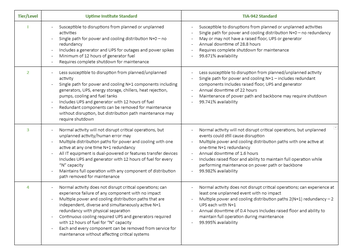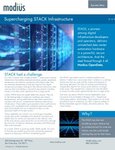As a business leader, you are constantly bombarded with tactical questions and, oftentimes, the right answers aren’t clear. While it’s human nature to lean on experts for the not-so-straightforward decisions, it’s still vital to slow down and make educated choices for yourself. Today, I’m here to be your counsel on deciphering data center tiers.
While data centers are an integral part of nearly any successful business, the inner workings of this infrastructure still remain quite impenetrable to those not in the colocation industry. Instead of shaking your head in agreement when a data center tier number is muddled to you by a service provider, it’s important to lean into the logistics and ask: What does the number really mean?
Let’s dig in.
What are data center tiers?
Every data center can be assigned a specific tier number when it’s designed or updated, which can span from tier 1 to tier 4. In theory, the tier numbers are used to increase awareness of what it means to achieve various levels of data center reliability, but, inconveniently, the reason the tier number was selected can vary from organization to organization.
While infrastructure, capacities, functionalities and operational sustainability are typically accounted for when assigning a tier number, there is no universal tiering method or governing body overseeing the system. The lack of continuity across organizations dilutes the credibility of the numbers and blurs the lines for decision makers. Because of this, it’s pertinent to question everything and ask for a detailed explanation as to what they mean to the particular organization and/or how they can be verified.
Though there are many tiering systems available, The Uptime Institute and the Telecommunications Industry Association (TIA) are the most widely used on the market. Let’s explore these systems further.
How do the Uptime Institute and TIA compare?
The Uptime Institute system and the TIA system operate similarly, with a few glaring differences. For instance, the Uptime Institute's system aims to be more goal-oriented, opposed to adhering to rigid technical specification for how a data center should be designed and constructed. On the other hand, the TIA standard is more cut-and-dry, leaning heavily into the rating and the specific associated requirements for each level of redundancy and availability.
Additionally, unlike the Uptime Institute, TIA has no set-in-stone procedure for evaluating a data center against its standard and there’s no official team of evaluators to enforce the standards. Instead, TIA offers outlined requirements for each tier level, evaluating data centers without a hard fee. The Uptime Institute comes at a cost - and offers a certification to point to, which is viewed as valuable by many organizations (given its credibility is easily traceable online, HERE).
While there are a few noticeable differences, the four tiers have a striking amount of similarities, as seen in the side-by-side system comparison (left)
How should leaders proceed through ambiguity?
As noted above, the Uptime Institute system and the TIA system have many similarities and for the majority, both options are viewed as a reliable system of tiering. Yet, you may run into data center operators that carelessly make up their own tier definitions without tapping professionals. Unfortunately, some providers don’t verbalize that they’ve created their own tiers, leading customers to believe it was certified by a reputable system. This is why you must stay curious and never accept vague answers from your potential providers.
Operators who value their customers’ business will go one step further to explain why they are reliable - whether they point to their SSAE 16 or ISAE 3402 audits and/or help you conduct a thorough needs/risk assessment. When you select a data center provider, it should feel like a partnership - with honest dialogue about expansion plans or changing needs.
It’s important to do your homework and continue to have open communication to ensure you’re getting what you need to operate safely, securely and with a sense of confidence in your partner. Having a strong data center strategy is non-negotiable, but when you find a great partner, that strategy comes together with grace and longevity.






